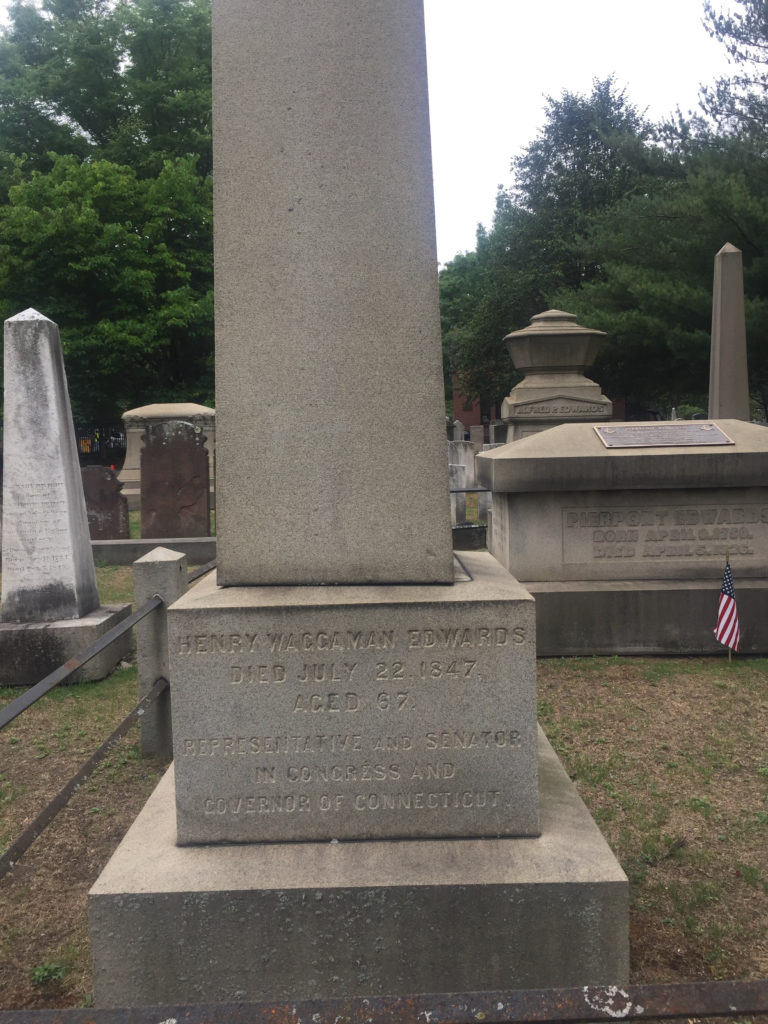Erik Visits an American Grave, Part 764
This is the grave of Henry Edwards.

Born in New Haven, Connecticut in 1779, Edwards grew up in the post-Revolutionary elite. Somewhat surprisingly, Edwards did not go to Yale, but rather to Princeton. I am not sure why. He graduated in 1797. I suspect the reason for this is that Yale was a Federalist institution and Princeton a Jeffersonian and southern institution, by and large. While Federalists dominated New England politics, Edwards was a strong Jeffersonian and later a Democrat. Edwards returned to Connecticut, studying law in Litchfield, and was admitted to the bar and opened a practice in New Haven.
Edwards was elected as to Congress in 1819, serving two terms. The Democratic Party didn’t exist yet but he work there was along the lines of those who would align with Jackson and Van Buren a few years later. While the Federalists had of course dominated Connecticut politics, Edwards came into his political career at a good time–after that party had been discredited by the Hartford Convention, collapsing into the brief single party nation of the Monroe years, and then much more evenly divided during the Second Party System years. That meant a Democrat such as Edwards had a chance for a pretty good career, even if the odds might be against it at times. During his second term in Congress, Connecticut’s senator Elijah Boardman died. Edwards was named to replace him. He stayed in Washington for the rest of the term, finishing that in 1827.
But rather than return to Washington, Edwards ended up back in Connecticut, whether by choice or not I don’t know. He was back in the state senate by 1828 and then the state house and then was Speaker in 1830. He was elected lieutenant governor in 1832, but the divided state house refused to seat him for reasons that no one seems to have an easy explanation for. Instead, Edwards ran for governor in 1833. Amazingly, these were 1-year terms. He lost in 1834, but then won again in 1835 and then two more times, serving until 1838. He seems to have been a reasonably effective governor, expanding railroad support and creating a state geological survey. He also helped segregate Connecticut schools. No abolitionist would a Democrat of that era be. But in 1838, the Democrats chose someone else to be the nominee. Edwards chose to leave politics at that time, going back to his law practice and living the life of a rich guy. He lived until 1847, dying at the age of 67.
Usually I can find some material on senators, but this is thin. I have a general policy when running across graves: I will write about any senator but a congressman? Those guys are a dime a hundred and most of them never did anything even remotely useful, very much including the current members of the House. So they have to do have actually done something I’ve heard of before I bother. But with the early 19th century, it’s a real mixed bag. Part of the reason that the political elite of that period–Clay, Webster, Calhoun, Benton, Van Buren, a few others–were so dominant is that there was so much turnover by people who didn’t see politics as a job that the lack of institutional knowledge placed a great deal of power in the hands of a few people. What did Henry Edwards offer the Senate during his two years? Just a reliable vote, not much else.
Henry Edwards is buried in Grove Street Cemetery, New Haven, Connecticut.
If you would like this series to visit other senators who served in the 1820, you can donate to cover the required expenses here. Charles Bouligny is in New Orleans and Nicholas Van Dyke is in New Castle, Delaware. Previous posts in this series are archived here.


